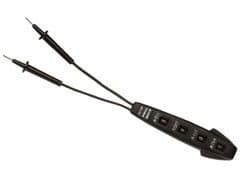How to Use a Automotive Continuity Tester
I've been doctoring appliances and electronics for a number of years. I'm here to share the knowledge and experience I've collected.

This article covers how to use a continuity tester to test fuses, lightbulbs, and wiring.
What Is a Continuity Tester?
Continuity testers are simple devices designed to verify a complete electrical path through an object or circuit. They are especially useful for checking fuses of all types, lightbulbs, and wire paths.
While there are a variety of devices that include the ability to test for continuity, a homeowner can easily get by with the simple single-purpose continuity tester. This is composed of:
- Two leads
- A small body where the leads meet
- Some form of indicator

Standard Fuse Contacts
How to Use a Continuity Tester
Testing Fuses
To test a fuse of any type, remove the fuse from the de-energized circuit either by pulling it completely out or, if this is not possible, removing the lead from one side or the other of the fuse.
Please note: Never attempt to test a fuse while it is still fully in the circuit. Sometimes, the signal will backtrack through another path and give you a false reading if you leave the fuse within the circuit.
With the fuse separated from its circuit, simply touch the two leads of the tester, one to each side, to the two contacts/metal caps/sides of the fuse. If the fuse is good, the indicator on the tester will indicate this fact. If it is not good, the tester's indicator will remain immobile.
Testing Lightbulbs
For a standard incandescent lightbulb, simply touch the two leads, one to the tip of the base of the screw portion, and one to the side of the screw portion of the removed lightbulb. If you are dealing with a cylindrical bulb (such as an overhead lamp in a car) then test it as you would a fuse. Please note: This type of tester will not work with fluorescent bulbs.
LEDs require a certain level of voltage, usually just over 1 volt, to force their internal circuit into continuity. Make sure your continuity tester is designed to test LEDs if this is your need.
Testing Wiring
You may also use this tester to verify that there is no break in a wire run. This ability is limited, of course, by the reach of the tester's leads but can be useful before making the final trims on audio wiring.
Scroll to Continue
Read More From Dengarden
Touch one of the leads to the starting point of the unenergized wire and touch the other lead to the ending point of the unenergized wire. If there are no breaks in the wiring, the tester will indicate continuity.
When testing a wire run, it is allowable to temporarily tie in a jumper wire to one end to get your wiring to reach the leads of the continuity tester.
Be aware that longer wire runs may fail a continuity test with your small tester simply due to the length of the run and not because of any break in the line. For longer runs, it is recommended you use a more expensive, better-designed tester to overcome this limitation.
This article is accurate and true to the best of the author's knowledge. Content is for informational or entertainment purposes only and does not substitute for personal counsel or professional advice in business, financial, legal, or technical matters.
smitty58 on November 19, 2013:
That is not a continuity tester!!
margie100 on June 04, 2011:
ok ok I wanted a quik answer so I called home depot and they told me the breaker in the "house" cause dryers don't have breakers that out of the way can you tell me what to do cause the the br3eaker box has only those off and on clikky thingies up and down so I don't know what to do about that please im lost
jess on May 19, 2011:
i have an amana dryer only 4 years old its heats at the beginning then cools down i see the flame light up but after 2 minutes it goes out...i replaced and cleaned my vents. pleas help
RTalloni on January 02, 2010:
Hope to see more of these type articles!
Source: https://dengarden.com/home-improvement/How-To-Use-A-Continuity-Tester